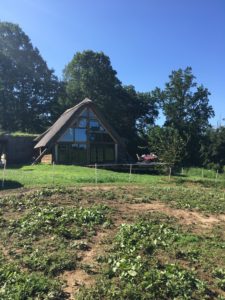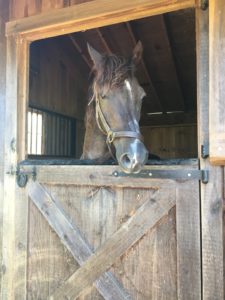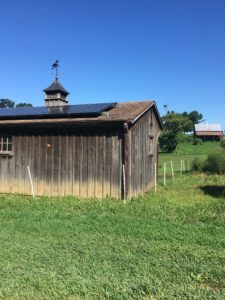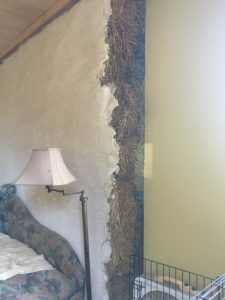Many of the projects that Lorax works on are large urban or suburban commercial buildings meeting a green building rating system, standard, or code. Tasteful low-emitting vinyl flooring, insulation made from recycled materials, elegant low-flow plumbing fixtures, and many more features are incorporated into these green buildings. While integrating these features into the design and construction of a building decreases the project’s overall environmental impact and operational costs, the majority of these buildings would be very out of place in a lush rural landscape.
Biomimmicary, the study and engineering of materials and buildings that imitate and seamlessly fit into the natural world is becoming more prominent in green building since being popularized in the late 1990s by Biologist Janine Benyus in her book Biomimicry: Innovation Inspired by Nature. Nature is smart – plants utilize solar energy, wool and straw are naturally insulating, and nature recycles or composts everything – so why not look to it for advice to build efficient, sturdy, and environmentally sound buildings? Utilizing the elements of nature can decrease project cost and environmental impact while creating something truly beautiful.
Eager to take a break from the city life, Lorax visited Look Forward Farm in Sparks, Maryland for some fresh air and green building inspiration. The farm is owned and operated by Dr. Polly Bart, President of Greenbuilders, Inc. Dr. Bart specializes in renovating and building green homes in Maryland. Because the majority of green buildings are commercial, Dr. Bart chose to specialize in residential renovations and new construction with the hope to positively impact the green building industry by encompassing more types of properties. She says that green building doesn’t have to cost more; it’s an integrative process where you simply have to think about the actions you are making ahead of time.
Look Forward Farm includes Dr. Bart’s home and a barn, which she calls a “laboratory for the use of local agricultural products in construction.” Living her values, Dr. Bart has built this barn to fit in with the rural landscape, and, in comparison to a conventional building, minimally disturb the earth on which it sits.
The barn, a sort of whimsical cottage, sits atop a small hill behind Dr. Bart’s primary residence. You travel along a dirt road to a hand paved medallion parking pad and are welcomed by a large rounded deck created from local woods. To your right, you’ll find Star, the Morgan horse, in a solar panel-covered stable. Look Forward Farm is the first in Baltimore County to have off -grid solar. To your left, you’ll see a green roof on the back of the barn, windows of various shapes and sizes adorning the front face of the barn, and the surrounding native plants on the remaining 34 acres of the property.
Inside, the barn features packed earth floors with a small section of reclaimed tiles underneath Dr. Bart’s desk, wool and straw insulation, plaster walls, and tree trunks for beams. You will find some sections of walls missing – a reminder of how the building is insulated and how green this barn truly is. The bathroom features some more reclaimed tiles and low-flow plumbing fixtures in addition to a composting toilet that Dr. Bart had a difficult time getting permits for.
If you look up from inside the main room of the barn, you’ll see the underside of the thatched roof. The roof is covered in phragmites, an incredibly invasive reed in the Chesapeake Bay area. Dr. Bart sourced it from Turkey and had an Irish thatcher install it. She ensured us that she triple and quadruple checked to make sure it would not cause the plant to spread throughout her property and beyond. It was a top choice for roofing material because water naturally travels along the reeds and helps to decrease the possibility of heat islands effect given its light color.
Look Forward Farm’s barn is living proof that green buildings can utilize locally sourced and natural resources without breaking the bank and without failing to impress. For more information on Dr. Polly Bart and her many projects, take a look at the Greenbuilders, Inc. website. She is actively looking for volunteers to help with on-site farm work.




